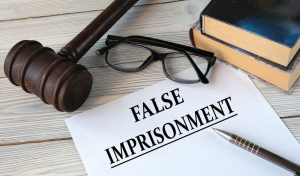 If someone detained or restrained you unlawfully, contact Wallace Miller immediately. You might be entitled to compensation for your physical or emotional injuries, losses, or other resulting expenses.
If someone detained or restrained you unlawfully, contact Wallace Miller immediately. You might be entitled to compensation for your physical or emotional injuries, losses, or other resulting expenses.
Someone who commits false imprisonment can face criminal and civil penalties. The offense is a type of intentional tort, meaning a person’s intentional actions harms someone. You can pursue legal action in civil court against the at-fault party for causing your injuries. The money you recover might compensate you for your medical treatment and other incurred costs from the incident.
At Wallace Miller, we understand the trauma you experienced. When someone holds you against your will, it can lead to significant physical and emotional strain. Some people require extensive medical care to recover.
You do not have to face the at-fault party alone. Let our team help you seek the justice you deserve.
Call the Chicago intentional tort attorneys of (312) 261-6193 for your free consultation to learn more about your available legal options.
Legal Definition of False Imprisonment in Illinois
Typically, false imprisonment is a term used to describe a civil offense in intentional tort cases. False arrest is one of the most common types of false imprisonment.
The Fourth Amendment requires law enforcement to have probable cause to believe a person committed a crime before they can arrest them. If they don’t have probable cause and arrest someone anyway, it is illegal and a violation of the person’s rights. A false arrest also occurs if an officer doesn’t present the person they arrested before a court or magistrate within a reasonable timeframe or without unnecessary delay.
Unlawful restraint is the term for describing the criminal offense of false imprisonment.
According to 720 ILCS 5/10-3, a person commits unlawful restraint when they knowingly and without legal authority detain someone.
Aggravated unlawful restraint is a more serious crime than unlawful restraint. It occurs when someone uses a deadly weapon while unlawfully restraining another person.
Multiple types of criminal charges can result from unlawful restraint.
Forcible Detention
720 ILCS 5/10-4 defines forcible detention as holding a person hostage to get someone to comply with their demands when the hostage-taker:
- Is armed with a dangerous weapon; or
- Knows the person being held hostage is a peace officer or correctional employee performing their official duties.
Kidnapping
False imprisonment becomes kidnapping if a person detains someone for a significant period or moves them to another location. According to 720 ILCS 5/10-1, a person commits kidnapping when they knowingly:
- And secretly confine someone against their will;
- Use force or the threat of imminent force to take a person from one place to another with the intent to confine them against their will secretly; or
- Use enticement or deceit to persuade someone to go to another location with the intent to secretly confine them against their will.
Aggravated kidnapping occurs when a person commits kidnapping and:
- Intends to obtain ransom from the kidnapped person or anyone else;
- Takes a child under 13 or someone with a profound or severe intellectual disability;
- Causes great bodily harm without discharging a firearm or commits another felony against the victim;
- Wears a robe, hood, or mask to conceal their identity;
- Kidnaps a person while armed with a dangerous weapon;
- Commits kidnapping while armed with a firearm;
- Discharges a firearm while kidnapping someone; or
- Discharges a firearm causing great bodily harm, permanent disfigurement, permanent disability, or death to another person.
Differences Between Criminal Cases and Intentional Torts
False imprisonment can result in either a criminal or civil case. The primary difference between the two is the result of the lawsuit. A criminal case involves criminal sentencing, while a civil case involves monetary penalties.
A person convicted of unlawful restraint or another type of false imprisonment by the state can face a prison sentence, fines, community service, and other penalties deemed appropriate by the court. In an intentional tort lawsuit, the defendant might have to compensate the plaintiff if the judge or jury rules in the plaintiff’s favor.
Another difference between intentional tort lawsuits and criminal cases is the burden of proof required to prove the defendant committed the act. The burden of proof is on the prosecution during a criminal case. The prosecutor must prove the defendant is guilty beyond a reasonable doubt. In a civil lawsuit, the plaintiff must show by a preponderance of the evidence that the defendant committed false imprisonment against their will, and that those actions injured them.
Who Can Lawfully Arrest Another Person?
Specific individuals are legally allowed to detain people. For example, law enforcement members can arrest a person if they have a warrant issued by a judge.
However, an officer can arrest someone without a warrant if these circumstances exist:
- The officer has grounds to believe the state or another jurisdiction issued a warrant for the arrest
- Someone commits a crime or attempts to commit a crime in front of a member of law enforcement
- A police officer has probable cause to believe the crime occurred and the person they’re arresting committed it
Private citizens can also detain or place another person under arrest in particular situations. The individual making a citizen’s arrest must have probable cause to believe someone is committing a criminal offense other than an ordinance violation. They can prevent the person they’re detaining from leaving the area until officers arrive.
Establishing Liability for False Imprisonment
 To establish someone’s liability in a false imprisonment case, you must prove these three elements:
To establish someone’s liability in a false imprisonment case, you must prove these three elements:
- Intent to confine – Intent to confine means the defendant intentionally confined you by threats of violence, physical restraint, deceit, or another intentional act.
- No legal authority to detain – A person must have the legal authority to detain someone. For example, a police officer can detain someone attempting to escape during an arrest. Even if detainment lasts a couple of minutes, it can be unlawful restraint under state law. Additionally, illegally detaining a person requires the victim not to give consent. If you give consent, you will unlikely receive compensation in a lawsuit.
- Inability to leave – An inability to leave is another crucial element you must prove in a false imprisonment case. The restraint must not allow you to leave the area. You may also know of a reasonable way to escape but can’t take the necessary action.
Some groups of people are exempt from liability for false imprisonment, including:
- Physicians
- Judicial officers
- Attorneys
- Government officials entrusted with judicial duties
If a judicial officer acts within their jurisdiction and in a judicial capacity, they are exempt from civil liability for the false imprisonment of another person. Officers in other government departments are also exempt if they exercise their judicial duty to restrain or detain someone. Attorneys are exempt if they act in good faith on behalf of their client while committing the act.
Compensation for Injuries from False Imprisonment
You could file a civil lawsuit against the at-fault party if you sustained injuries due to false imprisonment. You might receive compensation for your:
- Emergency room visits, hospital stays, and other medical bills
- Lost wages
- Lost earning capacity
- Pain and suffering
- Disfigurement or scarring
- Out-of-pocket expenses
- Loss of enjoyment of life
- Emotional distress
- Damage to personal property
You might also recover punitive damages. This financial award punishes a defendant for their misconduct and is meant to deter similar acts in the future. You must show clear and convincing evidence of the defendant’s evil motive or conscious indifference to the rights or safety of others and outrageous and reckless indifference to a highly unreasonable risk of harm to be awarded these damages.
Statute of Limitations for False Imprisonment
In Illinois, the statute of limitations for false imprisonment allows a two-year timeframe to file a lawsuit against another party for compensation. That means you must initiate your lawsuit in civil court within two years of the date of the incident. If the statute passes before you file, you will likely lose your right to pursue compensation for your losses.
You might be able to toll the statute of limitations. That means the two-year timeframe won’t start until a specific event occurs. The two scenarios allowing the tolling of the statute include:
- Unsound mind – If you are of unsound mind when false imprisonment occurs, you will have two years from the date you gain mental competency to file suit.
- Under 18 – If you are a minor during the incident, the two-year timeframe will start on your 18th
Contact a False Imprisonment Lawyer in Chicago
At Wallace Miller, we believe in holding people accountable for their wrongdoing. When someone injures another person, they should be liable for the various losses that result. We can represent you in your intentional tort case and seek the maximum possible compensation on your behalf.
If you were the victim of false imprisonment and suffered emotional or physical injuries, call us at (312) 261-6193 right now for your free consultation. We will protect your rights and fight by your side for justice.

